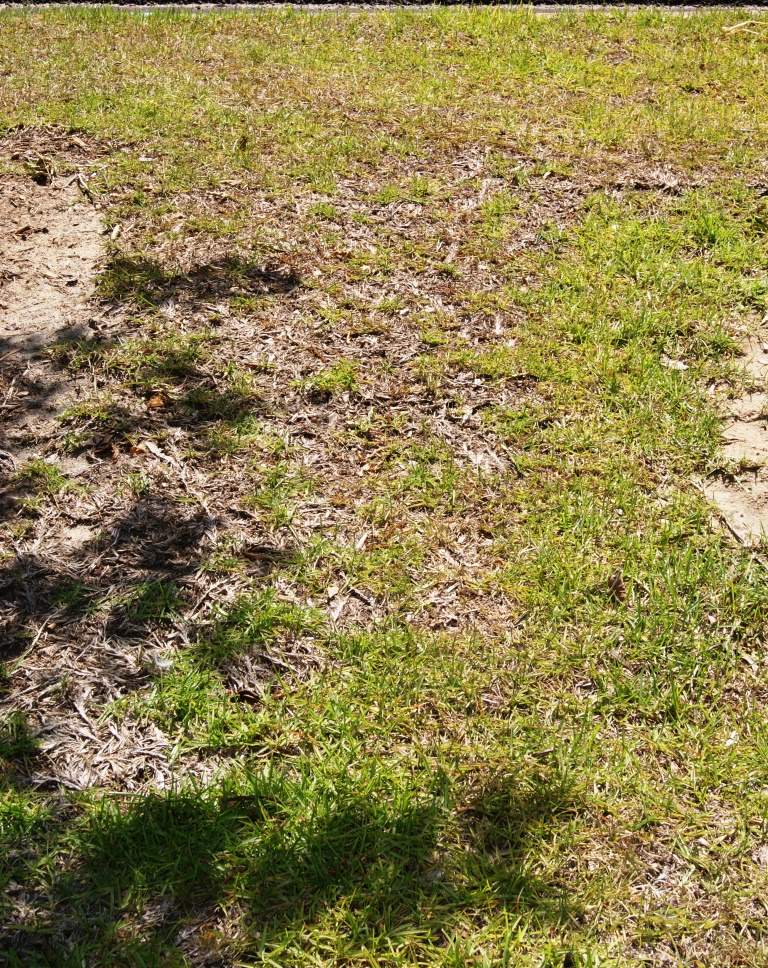
by Sheila Dunning | Feb 3, 2017
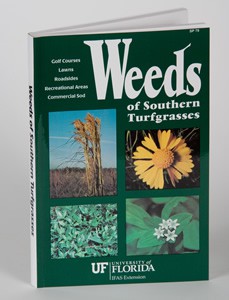 Remember last summer? The hot, dry days. Grass drying up and turning brown. Yet, the weeds are green and doing fine. However, every herbicide label warns against applying when the temperatures are above 85 degrees and especially under drought conditions. Those weeds flourished and dispersed seed everywhere. Now, they are just sitting there ready to sprout again.
Remember last summer? The hot, dry days. Grass drying up and turning brown. Yet, the weeds are green and doing fine. However, every herbicide label warns against applying when the temperatures are above 85 degrees and especially under drought conditions. Those weeds flourished and dispersed seed everywhere. Now, they are just sitting there ready to sprout again.
It’s time to start thinking about weed prevention. Pre-emergent herbicides need to be applied prior to seed germination. Late winter is the time to focus on summer annual weeds. The narrow window of application is challenging. Homeowners often wait too late into spring to put out preventative products. A general rule of thumb for pre-emergent herbicide timing is February 15 – March 1 in North Florida.
However, weed seeds germinate in response to soil temperature, not calendar dates. By monitoring day time temperatures, one can determine a more effective application date. When there are 4-5 consecutive days that reach 65 to 70 degrees weeds will germinate. This generally coincides with the first blooms appearing on azaleas and dogwood. With a warm winter it may occur as early as mid-January.
Some of the active ingredients in pre-emergent herbicides include dithiopyr, isoxaben, oryzalin, pendimethalin, prodiamine and simazine. Always read the label for specific weed controlled and observe all directions, restrictions and precautions.
Weed and feed products that contain nitrogen are not suitable as pre-emergent herbicides. Irrigation before and after application is necessary to activate these products. The chemical binds to soil particles, creating a barrier that remains effective for 6-12 weeks. Reapplication will be necessary for season long control, especially with constantly fluctuating winter temperatures. Now is the time to purchase pre-emergent herbicides and prepare to apply them. For more information on weed control in lawns go to: http://edis.ifas.ufl.edu/ep141
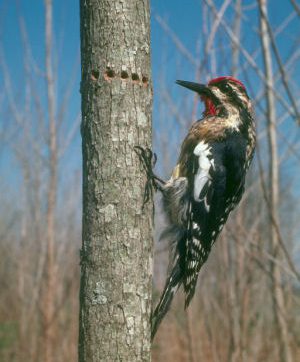
by Daniel J. Leonard | Feb 3, 2017
Have you noticed strange rings of pencil-sized holes on the trunks of certain trees in your landscape recently? If so, take heart that these holes are not emanating from an infestation of destructive insects but rather from a perfectly native, rather attractive migratory woodpecker, the Yellow-Bellied Sapsucker (Syphrapicus varius)!
The Sapsucker is a smallish bird with a chisel-like bill, easily distinguishable by bold black and white face stripes and a conspicuous bright-red crown and throat. If you have any problem identifying it by its features, look to its migration pattern, the Yellow-Bellied Sapsucker overwinters in mild winter areas of the Americas (like Florida’s Panhandle) and causes damage during this period (roughly December through March). If you notice a bird wreaking havoc on your backyard flora this afternoon, it is likely a Yellow-Bellied Sapsucker!
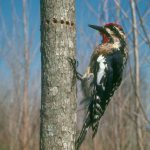
Yellow-bellied sapsucker (male) on pecan
James Solomon, USDA Forest Service, Bugwood.org
Like other members of its family, this woodpecker makes a living by “pecking” holes in trunks of trees and small shrubs about chest-high from the ground and feeds on sap and the occasional insect drawn to the sap. Fortunately, the damage is not usually harmful to the tree except in severe cases where the trunk may be girdled or secondary infection occurs from pests/diseases entering the tree through the holes. Unfortunately for Florida gardeners, this little bird has preferences in which trees it attacks, the majority of which are favorite landscape plants. For example, heavy feeding has been observed, both anecdotally by the author and more scientifically by researchers and birding enthusiasts, on Red Maple, Pecan, Chinese Elm, American Holly, Pine and Live Oak. They also really seem to enjoy any soft-wooded shrub limbed-up in a treelike form like Waxmyrtle, Viburnum and Dahoon Holly. Talk about frustrating!
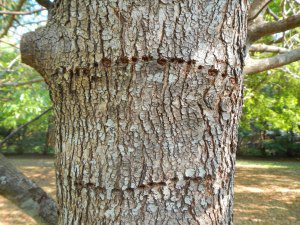
Sapsucker damage in a tree trunk.
Photo courtesy of Mississippi State Extension.
After learning that Sapsucker damage is not usually harmful, most homeowners opt to not control the birds’ feeding. However, if the aesthetic damage is not acceptable in your landscape, there are a few semi-effective control options and a host of other, less-effective home remedies. Wrapping the trunks of favored species with a loose, thick material such as burlap or felt is the preferred method of many ornamental nurseries and tree farms due to the material’s reusability and ease of removal after the migration has passed. Other commercial enterprises have had mixed success with hanging visually frightening CDs, pie plates and the like from low branches. Even less success has been seen with other homemade “cures” ranging from rubbing trunks of favored trees with Ivory soap to the use of sticky materials to deter perching. Shooting or trapping Yellow-Bellied Sapsuckers is not permitted as the birds are protected by state and federal wildlife law. As always, please contact your local UF / IFAS Extension office for advice and recommendations for other methods of discouraging unwanted bird visits!
Happy New Year and good gardening!

 Remember last summer? The hot, dry days. Grass drying up and turning brown. Yet, the weeds are green and doing fine. However, every herbicide label warns against applying when the temperatures are above 85 degrees and especially under drought conditions. Those weeds flourished and dispersed seed everywhere. Now, they are just sitting there ready to sprout again.
Remember last summer? The hot, dry days. Grass drying up and turning brown. Yet, the weeds are green and doing fine. However, every herbicide label warns against applying when the temperatures are above 85 degrees and especially under drought conditions. Those weeds flourished and dispersed seed everywhere. Now, they are just sitting there ready to sprout again.


